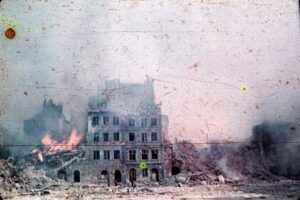80 years since the Warsaw Uprising – a view from the Third Camp


Warsaw Old Town in flames during Warsaw Uprising (Ewa Faryaszewska – Museum of Warsaw)
On August 1, 1944, the Home Army, the main underground resistance movement in wartime Poland, rose up against the Nazi occupation of Warsaw. The Home Army generals, linked to the Polish government-in-exile in London, had timed the operation to coincide with the German forces’ retreat ahead of the Red Army’s advance on the Eastern Front. For 63 days, the Poles fought valiantly, but in the end, the uprising was crushed. Around 16,000 Polish resistance fighters and between 150,000 and 200,000 civilians were killed. In a brutal reprisal, the Germans razed the city, destroying 80-90% of Warsaw’s buildings.
The uprising was ordered from on-high by right-wing generals who hoped to welcome the Red Army in the Polish capital as the bourgeois government-in-exile’s representatives and to reassert Polish sovereignty before Stalin’s puppet Polish Committee of National Liberation could assume control. Nevertheless, for most of the Polish population, the revolt was a push for national liberation and for retribution against the Hitlerite troops after five years of bloody occupation. Viewing the uprising in national-liberationist and anti-Nazi terms, forces like the Socialist Fighting Organization (Socjalistyczna Organizacja Bojowa) and the Jewish Fighting Organization (Żydowska Organizacja Bojowa) threw themselves into the fray.
Instead of reinforcing the Polish resistance fighters, Stalin ordered the Red Army to halt on the east side of the Vistula. There they stood idly by as the Poles fought and died, allowing the Nazis to regroup and put down the uprising. Declassified documents strongly suggest what many suspected at the time: that Stalin halted the advance on Warsaw to exhaust the Home Army, thereby helping establish a postwar, Soviet-aligned Polish government.
The American Trotskyist group the Socialist Workers’ Party (SWP) had split in 1940 after intense debates over, amongst other things, the question of “defense of the USSR” in light of the Soviet invasions of Poland and Finland. The “Orthodox” Trotskyists, led by James P. Cannon, remained in the SWP. They were “critically” but “unconditionally” for the “defense” of the USSR, which they saw as a “degenerated workers’ state.”
On August 19, 1944, in an editorial of the party’s periodical The Militant, titled “Warsaw betrayal,” the SWP condemned the Red Army’s actions. In their words, by launching the uprising, the Warsaw proletariat had proved that “five years of Nazi butchery have not tamed its fighting spirit nor destroyed its fighting powers.” By permitting the Nazis to crush the uprising, Stalin had shown “[t]hat his aims are counter-revolutionary, that he intends not to liberate the Polish people but to subjugate them.” The editorial called for Polish workers to organize independently from and in opposition to the Stalinists in order to “organize fraternization with the Red Army soldiers and help the Soviet masses to settle accounts with the bloody dictatorship of Stalin.”
On August 23, 1944, Cannon, who was in jail at the time, wrote a scathing letter to the SWP leadership in response to the Militant editorial. He deemed it inappropriate to call for “fraternization” with Red Army soldiers because the latter were the Polish workers’ allies against Hitler’s armies, not “the rank and file of a hostile military force.” Cannon reiterated that, while “[o]ur program recognizes the vital necessity of overthrowing Stalinism in the Soviet Union,” this task is second in importance to “the defense of the Soviet Union against imperialist attacks.” He criticized the editorial for taking “as its point of departure the assumption […] that Stalin deliberately maneuvered to permit Hitler to crush the revolt.” In Cannon’s view, it was “the duty of guerilla forces – and in the circumstances that is what the Warsaw detachments are – to subordinate themselves to the high command of the main army, the Red Army, in timing such an important battle as the siege of Warsaw.”
Underlying Cannon’s rebuke is the logic of Second Campism; that is, the idea that the world is fundamentally divided into two camps – the Western capitalist alliance (“First Camp”) and the Soviet-style societies (“Second Camp”) – and that socialists should support the latter against the former. In contrast, the Third Camp socialist tradition, which emerged from the “heterodox” side of the 1940 split in the SWP, came to view the Stalinist USSR as an exploitative class society that socialists should not support, even critically. In their view, socialists had to support the international working class against both the capitalist and Stalinist camps, hence their iconic slogan “Neither Washington nor Moscow, but international socialism!”.
Certainly, the kind of Second Campism at work in Cannon’s letter criticized the USSR’s repression of the working class and supported workers’ revolts against the Stalinist bureaucracies like those of 1956 and 1968. Still, the underlying assumption remained that, relative to capitalism, Stalinism was historically progressive – that, in their own flawed and contradictory way, the Stalinist states represented a step towards socialism. The SWP sang the praises of “Trotsky’s Red Army,” clinging to a millenarian faith that the Soviet advance would boost the socialist revolution in Europe despite Stalin.
Importantly, because Second Campist perspectives like the Orthodox Trotskyist one did not accept that the Stalinist bureaucracies were an exploitative ruling class in their own right, they could not recognize the USSR’s occupation of countries like Poland and installation of Soviet-aligned regimes in these countries as imperialism. While the end of the Cold War means there is no longer a Second Camp, one sees the continuing legacy of Second Campism on those parts of the left that support (“critically” or otherwise) regimes or movements purely because they are in conflict with Western imperialist powers, even if these regimes or movements themselves engage in imperialist predation or repress the working class.
In present-day Poland, the Warsaw Uprising looms large in nationalist “memory wars”. For socialists, Stalin’s decision to let the Nazis crush the uprising and the US Trotskyists’ responses to that decision hold valuable lessons: lessons about Stalinism’s capacity for the betrayal and slaughter of workers and about the extent to which even the anti-Stalinist left can end up accommodating to it in the name of “anti-imperialism.”